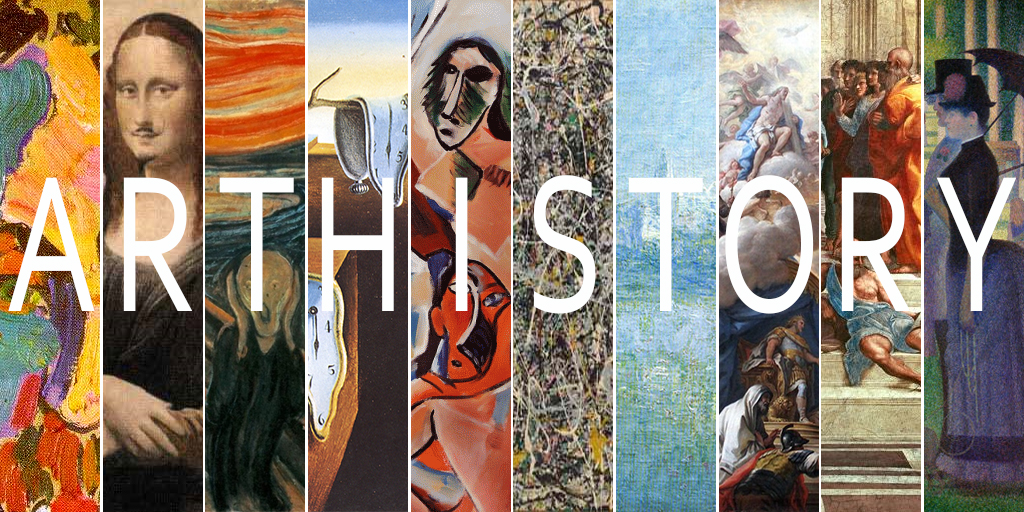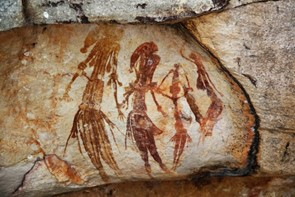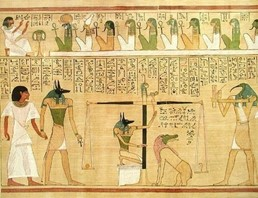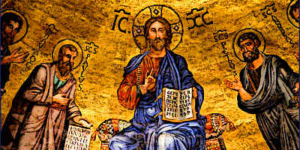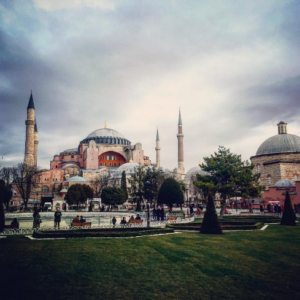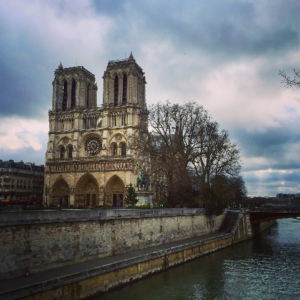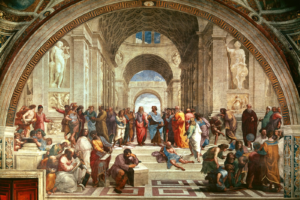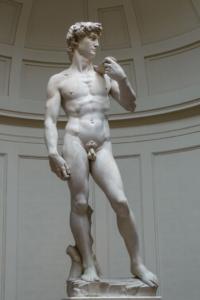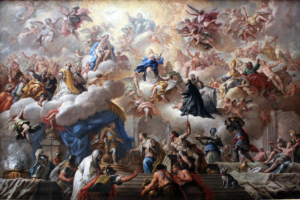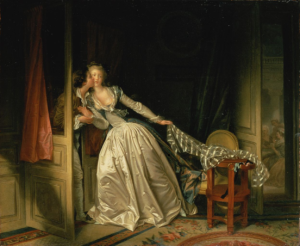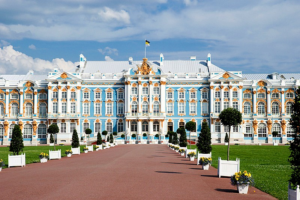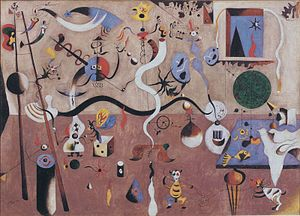Have you ever visited an art museum during your travels and been a little confused? What does it all mean? How are some pieces considered art? Why are some pieces so important and valuable? What are the various art history movements and periods? Why does it all matter?
I have been there many times. After visiting dozens of the best art museums in the world, I felt the need to actually understand and appreciate it. After a lot of reading, exploring, and conversation, I was able to piece together a basic understanding of Western art history. I became fascinated what each art movement said about what was going on in society and the prior art movement, and what artists were supporting or rebelling against.
I am still a beginner in the art world, but I have gained a basic understanding of how it all ties together and wanted to pass along an 80/20 perspective for you to get more out of any art museum experience.
Do not forget, art is everywhere. The street art you pass on the way to the museum may end up being as important to our current culture as a Picasso was in his day. Art movements are determined in hindsight to attempt to understand trends, so who knows what the future will say about artists and society today.
Ancient Art
Timeline: 30,000 BC – 500 AD
As long as there has been people, there has been art. There have been cave paintings and art creations found from throughout the Ice Age (10,000 – 8,000 B.C.) and Stone Age (8,000 – 2,500 B.C.). Here are the main categories of Ancient Art:
- Stone Age Art: cave paintings
- Mesopotamia Art: stone carvings with a focus on hunting and war
- Egyptian Art: paintings, sculptures, and jewelry with a focus on the afterlife (e.g., the Great Pyramids)
- Greek and Hellenistic Art: architectural monuments, sculptures, and crafts promoting the Greek idealism of balance and perfect proportions (e.g., the Parthenon)
- orders
- Roman Art: influenced by Greek art and culture, the Ancient Romans depicted mythological subjects through architectural design, sculptures, and paintings
Nearly everything we know about the belief systems and societies of the ancient world came from historians and archaeologists studying this art. It shows us that the desire to create art and tell stories is a core part of what it means to be human. Art history is as old as our species.
- Stone Age Art
- Ancient Egypt Art
- Ancient Greek Art
Medieval Art
Timeline: 500 – 1400
Medieval (think “middle”) Art was the time between Classical and Modern history. This is when Christianity was spreading through Europe and Islam in the Middle East, so naturally the focus was religion. It took the form of paintings, sculptures, stained glass, and mosaics. It is categorized into a few major periods: Early Christian, Migration Period, Byzantine (e.g., Hagia Sofia), Insular, Pre-Romanesque, Romanesque, and Gothic (e.g., Notre Dame). Medieval Art shaped the spread of the Roman Empire, Christianity, Islam, and the Ottoman Empire. Most of Europe, North Africa, and the Middle East has been designed and shaped by Medieval Art and the effects are prevalent to this day.
- Hagia Sofia
- Notre Dame
Renaissance Art
Timeline: 1400 AD – 1600 AD
Major Renaissance artists: Da Vinci, Michelangelo, Raphael, Donatello
The Renaissance period depicted a period of rebirth of classical culture. Artists applied new scientific knowledge to ancient traditions through paintings and sculpture. Prior art was focused entirely on religion. The Renaissance Art movement brought people back to earth and depicted reality, the human body, science, and technology. The art movement influenced a new period in advancing human thought.
- The School of Athens by Raphael
- David by Michelangelo
Mannerism Art
Timeline: 1527 – 1580
Major Mannerism artists: Jacopo da Pontormo, Rosso Fiorentino, Agnolo Bronzino, Alessandro Allori.
Inspired by Renaissance and Baroque artists and current events like Magellan circumventing the globe, Mannerism art attempted to break the rules of reality. Artists used elongated and disproportionate figures to show our dominion over the natural world.
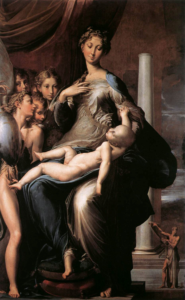
Baroque Art
Timeline: 1600 – 1750
Major Baroque artists: Rembrandt, Caravaggio, Óbidos, Bernini
During the Thirty Years’ War between Catholics and Protestants, art was used as a weaponry tool. Baroque art focused on displaying the magnificence of God. Frescoes and paintings were used to depict dramatic biblical scenes with movement and emotion.
- The Triumph Of The Immaculate by Paolo de Matteis
- Trevi Fountain in Rome
Rococo Art
Timeline: 1700 – 1800
Major Rococo artists: Jean-Antoine Watteau, Francois Boucher, Jean-Honor Fragonard, Clodion Claude Michel, Francesco Bartolomeo Rastrelli
The Rococo Art began when the French King, Louis XIV, demanded that more youthful art be produced under his reign. Art, furniture, and architecture created during this period demonstrated royal luxury. It is characterized as ornate and decorative design. Many churches of the time did not allow Rococo art and design because they believed it detracted from the solemnity of prayer.
- The Stolen Kiss by Jean-Honoré Fragonard
- Catherine Place in Saint Petersburg, Russia
Neoclassical Art
Timeline: 1750 – 1850
Major Neoclassical artists: Jacques-Louis David, Jean-Auguste-Dominique Ingres
During the Enlightenment and Industrial Revolution, Neoclassical artists sought to bring back the classic elements of Greco-Roman grandeur. Artists moved away from the decorative and ornate.

Oath of the Horatii by Jacques-Louis David
Romanticism Art
Timeline: 1780 – 1850
Major Romanticism artists: Eugène Delacroix, Caspar David Friedrich, Philipp Otto Runge
With the American and French Revolution, there was a movement towards individuality and imagination outside of political and social structures. Artists used strong emotion in their work and focused on the heroic achievements of the individual, whose examples could help raise society. The Romanticist used art to promote an agenda of freedom and the individual imagination. This had a significant effect on the political systems of the day, and influenced liberalism, radicalism, and nationalism
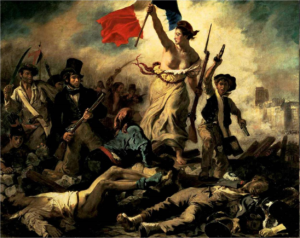
Liberty Leading the People by Eugène Delacroix
Realism Art
Timeline: 1848 – 1900
Major Realism artists: Gustave Courbet, Jean-François Millet, Honoré Daumier, Jean-Baptiste-Camille Corot
Inspired by the American and French Revolutions, European democratic revolutions ensued. In response to the Romanticism period, Artists began depicting objective reality and celebrated the working class. Realism Art is seen as the first modern movement that was explicitly anti-institutional and nonconformist. The movement attacked the traditions and values of the bourgeoisie and monarchy upon who controlled art – as well as society.
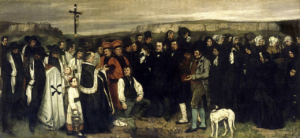
A Burial at Ornans by Gustave Courbet
Impressionism Art
Timeline: 1865 – 1885
Major Impressionist artists: Claude Monet, Pierre-Auguste Renoir, Berthe Morisot, Camille Pissarro, Alfred Sisley, Edouard Manet, Gustave Caillebotte
Impressionist Artists began painting the effects of light in every day subjects. Paintings depict visible brush strokes and vivid colors.
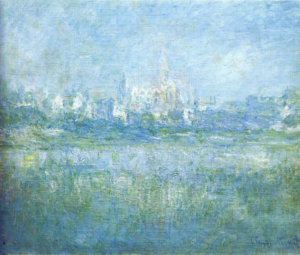
Vetheuil in the Fog by Claude Monet
Post-Impressionism Art
Timeline: 1885 – 1910
Major Impressionist artists: Vincent van Gogh, Paul Cézanne, Paul Gauguin, Georges Seurat, Henri Rousseau
Post-Impressionism began as a revolt against Impressionism. Artists used the same visible brush strokes, vivid colors, and real-life subjects, but they emphasized geometric shapes and experimented with the expressive qualities of the subjects.
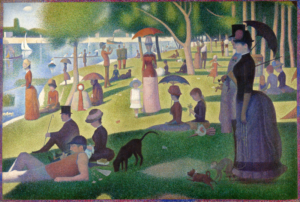
Sunday Afternoon on the Island of La Grande Jatte by Georges Seurat
Modern Art History
Timeline: 1880 – 1970
As described by the Museum of Modern Art in New York City: “Prior to the 19th century, artists were most often commissioned to make artwork by wealthy patrons, or institutions like the church. Much of this art depicted religious or mythological scenes that told stories and were intended to instruct the viewer. During the 19th century, many artists started to make art about people, places, or ideas that interested them, and of which they had direct experience. With the publication of psychologist Sigmund Freud’s The Interpretation of Dreams (1899) and the popularization of the idea of a subconscious mind, many artists began exploring dreams, symbolism, and personal iconography as avenues for the depiction of their subjective experiences. Challenging the notion that art must realistically depict the world, some artists experimented with the expressive use of color, non-traditional materials, and new techniques and mediums. One of these was photography, whose invention in the 1830s introduced a new method for depicting and reinterpreting the world. The Museum of Modern Art collects work made after 1880, when the atmosphere was ripe for avant-garde artists to take their work in new, unexpected, and “modern” directions.”
Here are the main types of Modern Art:
Expressionism
Timeline: 1900 – 1910
Major Expressionist artists: Ernst Ludwig Kirchner, Edvard Munch, Wassily Kandinsky
Artists began depicting an emotional experience rather than reality.
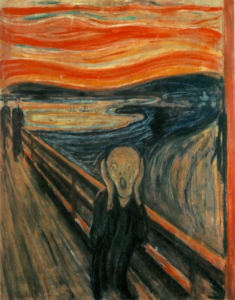
The Scream by Edvard Munch (Expressionism)
Fauvism
Timeline: 1905 – 1907
Major Fauvist artists: Matisse
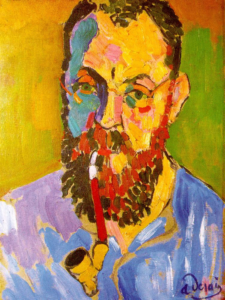
Portrait of Henri Matisse by André Derain (Fauvism)
Cubism
Timeline: 1908 – 1914
Major Cubist artists: Pablo Picasso, George Braque
Cubism was a unique artistic style where artists used new forms to express modern life. This was a period of major global shifts, from World War I, the height of women’s suffrage in the United States, and the Russian Revolution. Artists began to use broken, reassembled and abstracted forms of a subject to depict reality.
“Cubism is like standing at a certain point on a mountain and looking around. If you go higher, things will look different; if you go lower, again they will look different. It is a point of view.” – Jacques Lipchitz
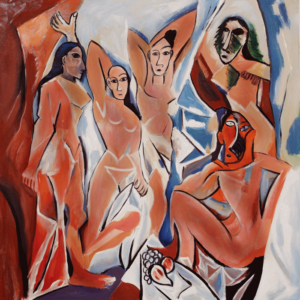
Les Desmoiselles d’Avignon by Pablo Picasso
Futurism
Timeline: 1909 – 1918
Major Futurist artists: Umberto Boccioni
Following the same trends as Cubism, Futurist artists began reimagining and transforming everything in new ways. They explored new mediums for art, such as interior design, and attempted to innovate how we see the world. Futurism celebrated modernity and technological advancements.

The City Rises by Umberto Boccioni
Dadaism
Timeline: 1916 – 1923
Major Dada artists: Marcel Duchamp
Created in the middle of World War I, Dada art was seen as response to the seriousness of war and was both anti-war and anti-art. Dada artists used humor and rebellion to reject traditional standards for art.
“Dada was the first conceptual art movement where the focus of the artists was not on crafting aesthetically pleasing objects but on making works that often upended bourgeois sensibilities and that generated difficult questions about society, the role of the artist, and the purpose of art.” – The Art Story
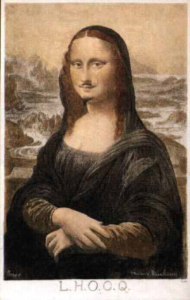
LHOOQ by Marcel Duchamp
Surrealism
Timeline: 1924 – 1940
Major Surrealist artists: Salvador Dali
Surrealism art was created to create an imagined world. Surrealist artists experimented with reality and used dreamlike qualities.
“The Surrealist artists sought to channel the unconscious as a means to unlock the power of the imagination. Disdaining rationalism and literary realism, and powerfully influenced by psychoanalysis, the Surrealists believed the rational mind repressed the power of the imagination, weighting it down with taboos.” – The Art Story
- The Persistence of Memory by Salvador Dali
- Harlequin’s Carnival by Joan Miró
Abstract Expressionism
Timeline: 1940 – 1950s
Major Abstract Expressionist artists: Jackson Pollock
This post-World War II art movement put New York City at the center of the art world, a position long held by Paris. Abstract Expressionism is categorized by its spontaneous and subconscious creation, emotional intensity, and use of fields of color and abstract forms. For the first time, the canvas was seen as an arena for which the painter could act, rather than a picture.
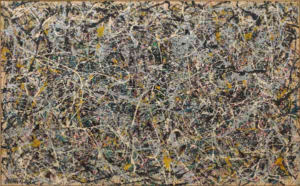
Number 1 (Lavender Mist) by Jackson Pollock
Pop Art
Timeline: 1960s
Major Pop Art artists: Andy Warhol, Roy Lichtenstein, James Rosenquist, and Claes Oldenburg
In response to Abstract Expressionism, Pop Art used popular imagery from popular culture and mass media. They rejected the traditional themes of morality and mythology by celebrating images of everyday life.
“Pop is everything art hasn’t been for the last two decades. It’s basically a U-turn back to a representational visual communication, moving at a break-away speed…Pop is a re-enlistment in the world…It is the American Dream, optimistic, generous and naive.” – The Art Story

Campbell’s Soup Cans by Andy Warhol
Minimalism
Timeline: 1960s
Major Minimalist artists: Carl Andre, Dan Flavin, Robert Irwin, Donald Judd
Minimalism was another response to Abstract Expressionist. Minimalist artists began depicting less dramatic displays of emotion and used anonymity over expressive excess. Painters and sculptors avoided strong emotion or symbolism and simply tried to create something cool and interesting.
Minimalism tried to show the world what minimalist artist, Donald Judd said, “A work of art needs only to be interesting.”

Die by Tony Smith
Postmodern Art
Timeline: 1960s – today
Art continues to transform and artists are working with a variety of mediums to continue to push the limits of how we see the world. As The Art Story states about the continued postmodern movements since Pop Art and Minimalism, “These movements are diverse and disparate but connected by certain characteristics: ironical and playful treatment of a fragmented subject, the breakdown of high and low culture hierarchies, undermining of concepts of authenticity and originality, and an emphasis on image and spectacle. Beyond these larger movements, many artists and less pronounced tendencies continue in the postmodern vein to this day.”
As Jean Baudrillard said well, “Postmodernity is the simultaneity of the destruction of earlier values and their reconstruction. It is renovation within ruination.” As you can probably see from reading this guide to art history, I believe this quote can apply to every art movement when compared to the period before it.
I hope you enjoyed my Quick Guide to Understanding Art History!
If you enjoyed this art history post, you can follow me on Instagram or sign up for my free weekly digest about ways to travel the world, build a successful business or career, and make a difference at the same time:
Error: No feed found.
Please go to the Instagram Feed settings page to create a feed.
A Quick Guide to Understanding Art History & Why It Matters

